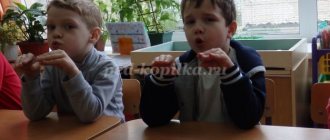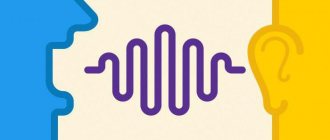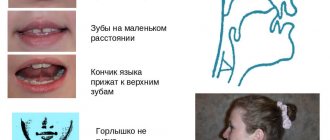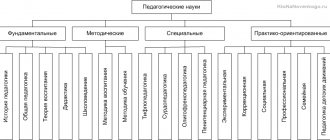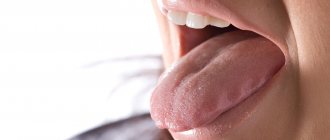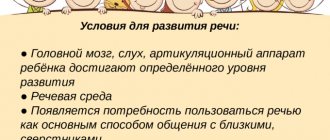1. Pronunciation of the sound [S] 2. The difference between the articulation of the sound [Z] and the sound [S] 3. Articulation of the sound [C] 4. Methods of setting the sounds [S], [Z], [C] step by step 4.1. Lip exercises 4.2. Gymnastics for the tongue 4.3. Breathing exercises 5. Second stage of production 6. Automation of sounds [S], [Z], [C]. Working with cards.
Work to eliminate the shortcomings of pronouncing the sounds [С], [З], [Ц] in most cases requires lengthy and painstaking actions. The teacher needs to clearly imagine the correct articulation of these sounds.
Pronouncing the sound [S]
- the lips slightly stretch into a smile, except in those cases when the subsequent phonemes are the vowels [O] and [U], which leads to anticipatory rounding of the lips;
- the teeth are either compressed or brought together, leaving only a narrow gap (about 1-2 mm);
- the tip of the tongue rests on the gums of the lower incisors, its back is curved, and the lateral edges are adjacent to the upper molars;
- along the tongue, in its middle, a groove is formed, which at the alveoli opens outwards with a narrow round hole;
- the soft palate is raised and closes the passage of air into the nasal cavity;
- The vocal cords are open and freely allow exhaled air to pass into the pharyngeal and oral cavities. The air stream is narrow, cold, strong.
Correction of dyslalia
Speech therapy work to correct dyslalia consists of the following stages:
- Examination of a child’s sound pronunciation;
- Correction of impaired speech sounds:
- Development of articulatory motor skills;
- Formation of skills in distinguishing speech sounds based on acoustic and articulatory features (work on phonemics);
- Production of disturbed sounds;
- Automation and introduction of formed sounds into speech.
The following stages are distinguished in the work on correcting sound pronunciation:
- Preparatory;
- Sound production;
- Sound automation;
- Sound differentiation.
The purpose of the preparatory stage is to prepare the organs of the articulation apparatus for the pronunciation of sounds: at this stage, the accuracy, strength and differentiation of movements of the articulation organs are worked out; work is underway to develop speech exhalation. At the preparatory stage, the child learns to perform articulatory gymnastics exercises, as well as various breathing exercises.
Important to remember! There is a basic set of exercises for developing the basic movements and position of the organs of the articulatory apparatus. Additional sets of exercises necessary for staging certain groups of sounds are selected for the basic complex.
Important to remember! Exercises to develop speech breathing help children develop targeted exhalation, which is necessary for mastering difficult-to-pronounce sounds.
Instructions for performing articulation gymnastics, as well as a list of exercises, can be read in our article
Video of articulation gymnastics:
Photos and videos of breathing exercises
Methods for setting sounds [S], [Z], [C] step by step
As diverse as the defects in pronouncing the sounds [S], [Z], [Ts] are, the ways to overcome them are just as diverse. To produce whistling sounds, complex and precise movements of the tongue are required, which involve the tip of the tongue, the lateral edges of the tongue, and the back of the tongue. Also necessary are precise movements of the lips (in a smile), the lower jaw (barely lowered) and the presence of an air stream (sufficiently strong and moving in the middle of the tongue). To develop the necessary movements of the lips and tongue, a series of articulation exercises should be performed.
Lip exercises
"Smile"
. Smile so that the upper and lower teeth are visible, hold this position for 5-7 seconds.
"Tube"
. Extend lips with a tube:
1st option - pronounce the sound [U] for a long time without using your voice;
2nd option - pull your lips slightly forward, as if forming a square. The teeth are closed.
"Doors Open"
. Slowly open your mouth until there is a distance of 10-15 mm between the upper and lower teeth, hold your lips in the “Smile” position.
"Bunny"
. Smile so that your upper and lower teeth are visible, raise your upper lip (wrinkle your nose), and lower it back into place.
Lower your lower lip and open your lower teeth. Lips and teeth are closed. Repeat 5-7 times.
Gymnastics for the tongue
"Pancake"
. Place a wide, relaxed tongue on the lower lip.
Make sure that the lower lip does not tense. The upper teeth should be exposed (that is, the “Smile” position is maintained). If the tongue does not take the desired shape, it is recommended to do a passive massage, pronounce syllables with the tongue sticking out between the lips, for example “ba-ba-ba”.
Upon achieving success, make your tongue wide without pronouncing these syllables and blow with a narrow cold stream of air until a groove is formed along the midline of the tongue.
"Swing"
. Raise your wide tongue over your upper teeth and then lower it behind your lower teeth. Perform the exercise counting 8-10 times.
"Let's brush our teeth"
. Smile, show your teeth, open your mouth slightly and “clean” your lower teeth with the tip of your tongue, first moving your tongue from side to side, then from bottom to top.
"Slide"
. Smile, show your teeth, open your mouth, place the tip of your tongue behind your lower incisors, pushing the middle part of the back of your tongue forward (“built a slide”).
"Monkey"
. Bite the side edges of the tongue (perform the “Gorka” exercise) and, holding the tip of the tongue behind the lower teeth, bite the side edges of the tongue on the right and left (you can pronounce “ey-ey-ey”). If this doesn’t work, then pronounce the sound “i-i-i”, stretching your lips as much as possible and holding the tip of your tongue behind your lower teeth.
"Pussy is angry"
. Smile, show your teeth, open your mouth, place the tip of your tongue behind your lower incisors, arch your back and stroke it with your upper teeth. In this case, you need to make sure that the lower teeth do not move forward.
“High slide - low slide”
. Lower the tip of the tongue behind the lower teeth, pushing the middle part of the back of the tongue forward (“high slide”). Holding the tip of your tongue behind your teeth, pull the middle part of the back of your tongue deep into your mouth (“low slide”). Repeat 3-4 times.
Breathing exercises
"Breeze"
. Simply blow through closed lips, controlling the stream of exhaled air using a strip of paper brought to your mouth, a piece of cotton wool suspended on a thread, or simply by feeling the stream on your hand brought to your mouth.
"Put the ball into the goal"
. Stretch your lips forward with a tube and blow for a long time onto a cotton ball (lying on the table in front of the child), driving it between two cubes.
“Who will kick the ball further?”
Smile, place the wide front edge of the tongue on the lower lip, as if pronouncing the sound [F] for a long time, blow the cotton wool onto the opposite edge of the table. The lower lip should not be pulled over the lower teeth. Make sure that the child does not puff out his cheeks and pronounces the sound [F], not [X].
"Singing Bubble"
. The exercise is done in front of a mirror with the tongue stuck wide between the lips, its lateral edges adjacent to the corners of the mouth. A longitudinal groove should form in the middle of the tongue. Holding the vial (test tube) vertically, you should bring its hole to the middle part of the front edge of the tongue. If, at the moment of blowing, a groove is formed along the tongue, along which an air stream rushes, then when the bubble (test tube) is brought to the tongue, a strong noise should be heard, which indicates the correct alignment of the tongue.
"Focus"
. Smile, open your mouth slightly, place the wide front edge of your tongue on your upper lip so that its side edges are pressed and a groove is formed in the middle, and blow off the cotton wool placed on the tip of your nose. The air should go in the middle of the tongue, then the fleece will fly up.
The sound r is a consonant, hard, trembling.
The sound ry is a consonant, soft, trembling.
The correct aticulation of the sound p is as follows:
- lips - half-opened or occupy the position necessary to pronounce the subsequent sound (usually a vowel);
- teeth - open;
- tongue - the wide tip of the tongue is raised upward to the tubercles behind the teeth (alveoli), tense, the back of the tongue is raised, air passes freely between it and the palate, the lateral edges of the tongue fit tightly to the upper molars;
- vocal cords - vibrate, giving voice;
- the air stream is very powerful; when exhaling, it passes through the oral cavity, hits the tense tip of the tongue and vibrates it.
The soft sound r differs in articulation from the paired hard sound p by the additional rise of the middle part of the back of the tongue towards the palate and some movement forward.
Sound production.
The child pronounces the sound z with the articulation indicated above, which resembles the sound r , but without vibration of the tip of the tongue. If instead of r you hear the sound z, you need to ask the child to move his tongue closer to his teeth. Slightly intensifying the air stream by adding the sound a, we hear the syllable ra. With other vowels the sound combinations ry, ro, ru are obtained. This preparation gradually and firmly establishes correct articulation in the child, but without vibration of the tip of the tongue. The resulting sound p is called proto
Characteristics of the sounds L, L and the correct position of the speech organs when pronouncing them.
The sound l is a consonant, voiced, hard.
The sound l is consonant, sonorous, soft.
During the correct pronunciation of the sound l, the speech organs take the following position:
- the lips are open, occupy a neutral position or take the position of the subsequent vowel sound;
- the teeth are slightly open;
- tongue - the narrow tip of the tongue rises and rests on the upper incisors or their gums, the middle part of the tongue is lowered, the lateral edges are also lowered;
- a gap remains between the lateral edges of the tongue and the molars, through which an air stream emerges.
- The vocal cords are tense and vibrate to produce the voice.
The soft sound l differs from the hard sound as follows:
- lips stretched to the sides, as if smiling;
- tongue - the tip of the tongue is raised slightly higher and rests on the alveoli (“tubercles”) behind the front upper teeth, the middle and back parts of the tongue are raised and moved forward, which gives softening.
Characteristics of hissing sounds and their articulation.
The group of hissing sounds includes the sounds sh, zh, ch, shch .
Sound Sh.
The sound sh is consonant, dull, hard. There is no corresponding soft sound in the Russian language.
When pronouncing the sound w, the speech organs normally take the following position:
- the lips are slightly pushed forward;
- the tip of the tongue is raised to the palate (to the alveoli), but does not touch it, forming a gap;
- the lateral edges of the tongue are pressed from the inside to the upper molars or hard palate, without allowing a stream of exhaled air to pass along the sides. Thus, the tongue takes the shape of a ladle or cup.
- the vocal cords are open, the stream of exhaled air passes freely between them;
- the air stream is exhaled evenly in the middle of the tongue, it is strong, wide, warm, and can be easily felt with the back of the hand raised to the mouth.
Any deviation from the correct articulation pattern leads to sound distortion. When producing a sound, our main task is to create in the child the correct articulation of this sound.
The articulation of the sound w differs from the articulation of the sound w by the presence of a voice.
The articulation of the sounds sh and ch differs from the articulation of the sound sh by the additional rise of the middle part of the tongue towards the palate. In addition, the sound h is a closure-fissure, i.e., when it is articulated, the front part of the back of the tongue first closes with the alveoli, and then a gap is formed between them.
Thus, for the hissing sounds sh, zh, shch, ch, the main articulation of the sound sh , and this means that it will be basic for this group. That is, work on correcting hissing sounds must begin with the sound w . If the sound w is pronounced correctly, then by adding a voice we get the sound w ; by adding the rise of the middle part of the tongue, we get w ; adding the rise of the middle part of the tongue and the bow in front of the gap, we get h . Therefore, violations of the sounds zh, shch, ch are the same as those of w .
Sound production.
After the child learns to spread his tongue and bend it upward, the adult suggests to him: “Open your mouth slightly, lift your wide tongue over your upper teeth, like me. Now blow on your tongue. Do you hear how the wind rustled? (Air, passing through a small gap between the front edge of the tongue and the palate, forms a pinch, a pinching sound).
It happens that a child blows with the sound x , then the stream dissipates, the sound turns out fuzzy and distorted. In this case, he should be told: “Blow on the tip of your tongue, as if pronouncing the sound s , but keep your tongue up.”
Developing the correct sound sh requires repeated repetition and the use of various images (the wind makes noise, a snake hisses, air comes out of a burst balloon, etc.). The game form, combined with explanation, quickly focuses the child’s attention. Gradually, under the control of an adult, he begins to perform the required movements (round his lips and slightly move them forward) and correctly pronounce the sound sh .
It must be remembered that when introducing a sound, you should never call it to a child, so as not to cause him to habitually mispronounce it.
How is the sound Zh pronounced normally?
The group of hissing sounds includes the sounds sh, zh, ch, shch .
The sound is consonant, sonorous, hard. There is no corresponding soft sound in the Russian language.
When pronouncing the sound w, the speech organs normally take the following position:
- the lips are slightly pushed forward;
- the tip of the tongue is raised to the palate (to the alveoli), but does not touch it, forming a gap;
- the lateral edges of the tongue are pressed from the inside to the upper molars or hard palate, without allowing a stream of exhaled air to pass along the sides. Thus, the tongue takes the shape of a ladle or cup.
- the vocal cords are closed and vibrate under the pressure of the exhaled air stream;
- the air stream is exhaled evenly in the middle of the tongue, it is strong, wide, warm, and can be easily felt with the back of the hand raised to the mouth.
Any deviation from the correct articulation pattern leads to sound distortion. When producing a sound, our main task is to create in the child the correct articulation of this sound.
Sound setting [F].
After automating the sound sh in words, you can put the sound zh . Give your child the opportunity to feel the vibration of the vocal cords when pronouncing the sound z . Place the back of your baby's hand on the front of your neck. sh with your child and add your voice. With one hand the child should feel the vibration of your vocal cords, with the other - with himself.
An isolated sound is reinforced using onomatopoeia (imitation of the buzzing of a beetle, bee, bumblebee, rotation of a spinning top, etc.)
After the child learns to pronounce an isolated sound correctly, you can begin to automate it and introduce it into normal speech.
How to pronounce the sound Ch normally.
The sound Ch is consonant, dull, soft. There are no paired voiced and hard sounds in the Russian language.
At the moment of pronouncing the sound Ch, the organs of articulation occupy the following position:
- lips slightly pushed forward and rounded;
- the teeth are brought together, only a narrow gap remains between them;
- the wide tip of the tongue is raised to the front of the hard palate; the middle part of the back of the tongue is lowered, forming a depression; the lateral edges of the tongue are pressed against the upper molars;
- an air stream passes with force through a narrow gap between the alveoli and the front part of the tongue (at the beginning of articulation, the tip of the tongue closes with the base of the upper incisors, and then sharply moves back), the exhalation is stronger than when pronouncing the sound w, more intense, the air is exhaled with a push and passes in the middle of the tongue;
- the soft palate is raised, pressed against the back wall of the pharynx and closes the passage into the oral cavity;
- the vocal cords are not tense, they are spread apart, the voice is not formed.
- Sound production Ch.
- The sound Ch can be made in two ways.
- Method 1. t-t-t at a fast pace (the tip of the tongue touches the base of the upper incisors). Then we gradually begin to move the tip of the tongue back, as if stroking the upper alveoli. At the same time, we stretch our lips wide in a smile. The result should be a clear Ch sound.
- Method 2. First slowly, then increasing the pace, we pronounce a combination of sounds th and sh - dark . Don't forget to smile widely. It is important!
- Practice pronouncing the sound Ch in isolation for some time: “How does the clock tick?” - “Ch-ch-ch.” “How does a grasshopper chirp?” - “Ch-ch-ch.” “How to calm a noisy baby?” - “Ch-ch-ch.”
How to pronounce the sound [s] normally.
The sound [s] is a consonant, dull, hard. Paired with it in terms of hardness and softness is the sound [c'] (“s”). Paired in terms of voicedness and deafness is the sound [z].
When pronouncing the sound [s], the organs of articulation occupy the following position:
- - the lips are slightly stretched in a smile, so that the upper and lower incisors are exposed;
- - the teeth are brought together, forming a gap of 1-2 mm;
- - the tip of the tongue is wide, located in the lower part of the lower front teeth;
- - the lateral edges of the tongue are raised and tightly meet the upper lateral teeth;
- - the back of the tongue in its front part forms a narrow gap with the upper alveoli for the exit of a stream of air;
- - the air stream is strong, passes through the middle of the tongue and when you bring the back of your hand to your mouth it feels cold;
- - the soft palate is pressed tightly against the back wall of the pharynx, preventing air from escaping into the nose;
- - vocal cords are open and do not form a voice.
Attention! Any deviation from this articulation, which does not lead to distortion of the sound by ear, is considered a variant of the norm.
Sound setting [s].
Method 1. “Let's remember the exercise “Kick the ball into the goal.” Smile wide, show your teeth and say the sound [i] to yourself. Now, with such a beautiful smile, blow on the ball.” When performing this exercise, it is important to ensure that the lips do not come close, do not cover the teeth, and that the tip of the tongue is strictly behind the lower teeth. The result is a weak but clear [c] sound. The pronunciation of sound is fixed in onomatopoeia.
Method 2. If the first method did not work, you can use mechanical help. We make a wide smile, teeth are exposed, the tip of the tongue is behind the lower teeth. On the tip of the tongue we place a thin wooden stick in the middle, for example, a match without a sulfur head. We press lightly with a stick, thus forming a groove for an air stream along the middle line of the tongue. The child blows on the tip of his tongue. The sound [s] is heard. Attention! The air stream should be strong, narrow and feel cold (not warm!) when you bring the back of your hand to your mouth.
Mechanical assistance can be used at the stage of pronunciation of isolated sounds (onomatopoeia) and syllables. Then we gradually remove the stick. When the child learns to pronounce the correct sound [c] independently, without mechanical assistance, you can move on to automating this sound in words and sentences.
How to pronounce the sound [z] normally.
The sound [z] is a consonant, voiced, hard. Paired with it in softness is the sound [z'] (“z”), Paired in deafness is the sound [s].
When pronouncing the sound [z], the organs of articulation occupy the following position:
- - the lips are slightly stretched in a smile, so that the upper and lower incisors are exposed;
- - the teeth are brought together, forming a gap of 1-2 mm;
- - the tip of the tongue is wide, located in the lower part of the lower front teeth;
- - the lateral edges of the tongue are raised and tightly meet the upper lateral teeth;
- - the back of the tongue in its front part forms a narrow gap with the upper alveoli for the exit of a stream of air;
- - the air stream is strong, passes through the middle of the tongue and when you bring the back of your hand to your mouth it feels cold;
- - the soft palate is pressed tightly against the back wall of the pharynx, preventing air from escaping into the nose;
- - the vocal cords are closed and tremble, forming the voice.
Attention! Any deviation from this articulation, which does not lead to distortion of the sound by ear, is considered a variant of the norm.
How to pronounce the soft sound [z'] normally.
The sound [з'] ("зь") is a consonant, sonorous, soft. Its counterpart in hardness is the sound [z]. Paired in deafness is the sound [s'] (“s”).
When pronouncing the sound [з'], the organs of articulation occupy the following position:
- - the lips are slightly stretched in a smile, so that the upper and lower incisors are exposed;
- - the teeth are brought together, forming a gap of 1-2 mm;
- - the tip of the tongue is wide, located in the lower part of the lower front teeth;
- - the lateral edges of the tongue are raised and tightly meet the upper lateral teeth;
- - the back of the tongue in its middle part forms a narrow gap with the upper alveoli for the exit of a stream of air;
- - the air stream is strong, passes through the middle of the tongue and when you bring the back of your hand to your mouth it feels cold;
- - the soft palate is pressed tightly against the back wall of the pharynx, preventing air from escaping into the nose;
- - the vocal cords are closed and tremble, forming the voice.
Attention! Any deviation from this articulation, which does not lead to distortion of the sound by ear, is considered a variant of the norm.
Sound setting [z].
The sound [z] is easily differentiated from the sound [c], since these sounds have the same articulatory structure, that is, when pronouncing these sounds, the organs of articulation occupy the same position. The difference between the sounds is that [s] is voiceless, pronounced without a voice, and [z] is voiced, pronounced with a voice. Thus, to cause the sound [z], it is enough to add, “turn on” the voice when pronouncing the sound s.
The presence or absence of voice can be controlled by ear, as well as by tactile-vibration control. To do this, apply the back of the hand to the front surface of the neck in the larynx area. When you “turn on” your voice, your hand feels a slight vibration transmitted from the vocal folds. When you turn off the voice, the vibration disappears.
You can explain to children that when the little voice in the neck is “sleeping,” we don’t feel it, but when it wakes up, we can feel it jumping and having fun in its little house—the neck.
Having received the correct sound [z], you should practice pronouncing it for some time in isolation from other sounds: z-z-z. Children can be asked to ring like a mosquito or a bell.
After this, you can move on to sound automation, first in syllables, then in words, sentences and connected texts.
How to pronounce the sound Ts normally.
The sound Ts (in Russian transcription [ts]) is a consonant, deaf, hard. It is formed by merging the sounds [t] and [s] into a single sound. There are no sounds equivalent to it in terms of sonority and softness in the Russian language.
When pronouncing the sound [ts], the organs of articulation occupy the following position:
- - the lips are slightly stretched in a smile, so that the upper and lower incisors are exposed;
- - the teeth are brought together, forming a gap of 1-2 mm;
- - the tip of the tongue is wide, located in the lower part of the lower front teeth;
- - the lateral edges of the tongue are raised and tightly meet the upper lateral teeth;
- - the back of the tongue in its front part closes tightly with the upper alveoli for a split second, as when pronouncing [t], after which it forms a narrow gap with them (v. alveoli) for the exit of a stream of air, as when pronouncing [s];
- - the air stream is strong, jerky, passes through the middle of the tongue and when you bring the back of your hand to your mouth it feels cold;
- - the soft palate is pressed tightly against the back wall of the pharynx, preventing air from escaping into the nose;
- - vocal cords are open and do not form a voice.
Attention! Any deviation from this articulation, which does not lead to distortion of the sound by ear, is considered a variant of the norm.
How to pronounce the sound [k] normally.
The sound [k] is a consonant, dull, hard. Paired with it in terms of hardness and softness is the sound [k'] (“k”). Paired in terms of voicedness and deafness is the sound [g].
When pronouncing the sound [k], the organs of articulation occupy the following position:
- lips parted, stretched in a slight smile;
- teeth are open:
- the tip of the tongue lies at the base of the lower incisors,
- the front and middle parts of the back of the tongue are lowered,
- the back of the back of the tongue rises up and rests on the palate at the back,
- the lateral edges of the tongue are pressed against the upper lateral teeth;
- the soft palate is raised, pressed against the back wall of the pharynx and closes the passage into the nasal cavity;
- vocal cords are not tense, open - the voice is not formed;
- the air stream is strong, at the moment of pronouncing the sound it passes through the center of the oral cavity, breaking the bridge between the back of the back of the tongue and the palate.
Attention! Any deviation from this articulation, which does not lead to distortion of the sound by ear, is considered a variant of the norm.
Sound setting [k]
Ref. position: lips are parted, stretched in a slight smile, teeth are open, the tip of the tongue lies at the base of the lower incisors.
We pronounce the syllables TA-TA-TA...
While pronouncing the syllables, use a cleanly washed finger or the tip of a cotton swab to lightly press on the front of the back. tongue, gradually moving it back into the depths of the mouth. As the tongue moves away, we hear: TA-TA-TA-TA-TA-TA-KYA-KYA-KYA-KA-KA-KA.
We gradually weaken the mechanical assistance, reducing it to “nothing.” Now the tongue can hold the correct position on its own.
Second stage of production
If the child successfully copes with all the exercises, you can begin direct sound production.
The most common techniques for setting the sound [C] are the following:
- With your mouth slightly open, show the child in front of the mirror the difference between correct and defective articulation, and depict this using your hands. Having achieved the correct position of the tongue, you can turn on the exhalation and give the child the opportunity to feel the stream of exhaled air on the hand brought to the mouth.
- The sound [T] can be used as a basis for setting the sound [C], if it is pronounced correctly. You should ask the child to pronounce the sound [T] with some aspiration. The presence of aspiration should be controlled by feeling a stream of air on the hand. Then you need to invite the child to do the same, first resting the tip of the tongue on the gums of the lower incisors. Gradually, during the exercises, the fricative part of the continuous sound lengthens and then separates, after which it can be explained to the child that this is the correct sound [C].
- In more difficult cases (with lateral sigmatism), it is important to ensure that the air stream passes through the center of the tongue, so it is necessary to pay special attention to the exercises “Breeze” and “Who will kick the ball further?”.
- Having received the required result (the formation of a groove and the passage of a jet along it), we invite the child to raise his upper lip and blow. Gradually move the tongue to a position behind the lower teeth.
- Having lowered the tip of the tongue behind the lower incisors, the child should bite the lateral edges of the tongue and blow along the center of the tongue into the crack between the teeth.
The voiced sound [Z] is easily reproduced by simply adding the voice to the phoneme [S].
When automating the sounds [S], [Z], [C] in words, one should take into account the child’s articulatory abilities, his age, the ability to master semantics, and mastery of the syllabic structure of the word.
Diagnosis of dyslalia
If parents notice that a child by the age of 5 does not pronounce a number of sounds, or pronounces them distortedly and incorrectly, the best decision in this case would be a consultation with a speech therapist.
The speech therapist conducts an examination of sound pronunciation using special picture material. This procedure is carried out individually and/or in the presence of the child’s parents or legal representatives.
The material for examining sound pronunciation includes sets of pictures for different groups of sounds. The selection of subject pictures is made in such a way that each of the sounds being examined is at the beginning, middle or end of the name word, since the sound is pronounced differently in different positions. Pronunciation is checked using visual material:
- in the group of whistling consonants [s] [s'] [z] [z'] [ts];
- in the group of sibilant consonants [w] [zh] [sh'] [h];
- in the group of sonorant consonants [р] [р'] [л] [л'] [j] [ja] [je] [jo] [jy] [ji];
- in the group of back-lingual consonants [k] [k'] [g] [g'] [x] [x'];
- in the group of voiced consonants [v] [v'] [b] [b'] [d] [d'];
- in the group of voiceless consonants [f] [f'] [p] [p'] [t] [t'].
The speech therapist selects at least three pictures for each sound position in the word (at the beginning, middle, end).
When examining sound pronunciation, the speech therapist notes the absence, replacement, confusion, and distortion of sound. If the child finds it difficult to name the picture, the speech therapist suggests repeating the word after him (i.e., reflected).
During a speech therapy examination, the specialist pays attention to and records:
- features of speech tempo;
- clarity of words pronunciation;
- correct pronunciation of words (by syllable structure);
- sonority of voice.
Important to remember! At the “Easy to Speak” speech development center, it is possible to undergo a comprehensive speech therapy examination and obtain a specialist opinion.

